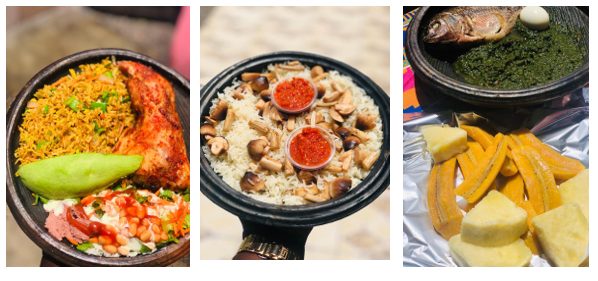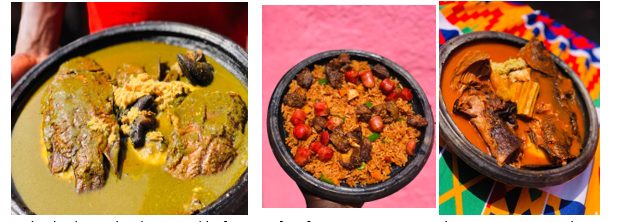Pottery is one of the oldest handicrafts in Ghana. It is the process and the products of forming vessels and other objects with clay and other ceramic materials, which are fired at high temperatures to give them a hard, durable form. Early men and women in Kwahu discovered that they could harden the molded pottery in hot ashes and make sturdy containers to transport and store foodstuffs.
It is one of the oldest human technologies and art-forms and remains a major industry in Ghana today. There are many regions in Ghana where pottery serves as the main occupation for the people. Clay is the material from which the pottery ware is made. Major type includes earthenware, locally called “Asanka or Ayewa”.

Earthenware is an integral part of Ghana’s culture throughout the pre-colonial era and still widely used in the 21st century among the Ghanaian populace. Earthenware was the first kind of pottery made, dating back to about 9,000 years. Some notable Kwahu towns in the mass production of pottery stuff are Mpraseso, Oframoase, Jejeti, Amanfrom and “Besease” in the Kwahu South and West Districts respectively of the Eastern Region in Ghana.
The town’s local inhabitants are commercially involved in pottery production especially women, producing different shades of earthenware’s, pots, bowls among others. Mention must be made of the fact that some techniques involved in making traditional earthenware vary slightly from place to place but generally include simple and cheap tools such as flat wooden bat, a metal ring, corncobs, sharp pointed sticks, shells, smooth pebbles, soft rags, a metal or flat wood with a serrated edge, pieces of calabash and marbles
Potters follow certain basic patterns of forms i.e., oval, circular and semi-circular forms especially for earthenware styles. The materials influence the forms potters make as well as the decorations used. The shape of the pottery vessel is primarily determined by the use for which it is intended and by the plasticity and other properties of the clay from which it is formed.

In traditional pottery, the oval form denotes pots for cleansing hence the oval shape of the Akan bathing pot “kutu”. The circular form denotes receptacles for liquids which are traditionally regarded as life-going and therefore sacred hence the container of drinking water of the Akan “Ahina” while the semi-circular form represents benevolence, tenderness of heart and kindness hence the Akan meal bowl “Ayewa” for earthenware.These “Ayewas” are made by forming a clay body into objects of a required shape and heating them to high temperatures in a kiln which removes all the water from the clay, this induces reactions that lead to permanent changes including increasing their strength and hardening and setting their shape.

A clay body can be decorated before or after firing. Prior to some shaping processes, clay must be prepared. Kneading helps to ensure an even moisture content throughout the body. Air trapped within the clay body needs to be removed. This is called de-airing and can be accomplished manually by wedging. Wedging can also help produce an even moisture content. Once a clay body has been kneaded and de-aired or wedged, it is shaped by a variety of techniques. After shaping it is dried and then fired.
According to Ashmore et al (2000), it is common for clays and other materials to be mixed to produce clay bodies suited to specific purposes. The two essential components of clay are Silica and Alumina which combine to form Aluminum silicate, also known as Kaolinite.
Other mineral compounds in the clay may act as fluxes to lower the melting point of the silica during firing. Hand building is the earliest forming method. Wares can be constructed by hand form coils of clay, combining flat slabs of clay or pinching solid balls of clay or some combination of these. Parts of hand-built vessels are often joined together with the aid of slip an aqueous suspension of clay body and water.

There are amazingly numerous reasons why earthenwares remain competitive in the Ghanaian setting despite the proliferation of steel utensils. Earthenware’s are inexpensive and easily available, very beautiful, has an unmatched aroma and taste, provides health benefits as clay pots mix well with acidic food to perfectly balance out the PH level of what one cooks, and it is heat resistant as well.
The promotion of earthenware has attracted many cultural tourists into the country who tend to pick these items as souvenirs and give away on their journey back home. Earthenware has grown to become a cultural tourism product for Ghanaian economy and in many instances has single handedly created a cultural niche for artifact operators. Kwahu has what it takes to build and promote the pottery industry in Ghana with the needed support.

>>>The writer is the Membership Director of the Kwahu Professionals Network and a native of Kwahu Aduamoa and Twenedurase. He is a Project Management Expert with over 13 years’ experience. He is currently the COO of Yopoo Clean Co. Ltd, manufacturers of cleaning detergents and the CEO of Dansons Investment. Email him at [email protected]









